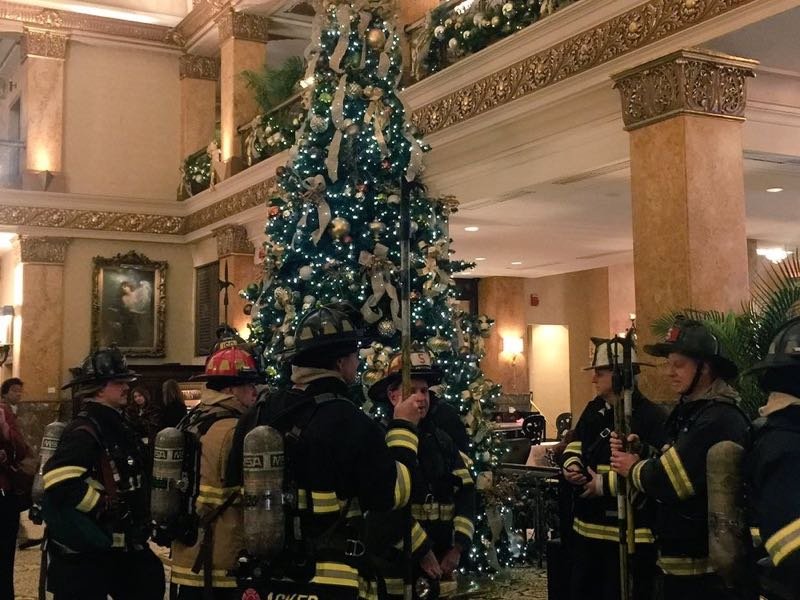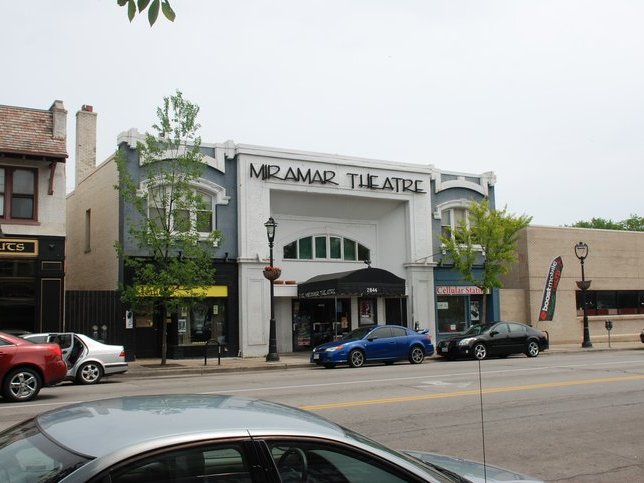Early Monday morning Milwaukee Fire Department crews responded to a two-alarm blaze on the South Side in a vacant turreted building on the corner of Mitchell Street and Muskego Avenue.
According to a WISN-TV news report, "When firefighters arrived, flames could be seen shooting from the roof and windows of the building."
Multiple buildings were damaged including one that partially collapsed. One of the affected buildings was home to a church, banquet hall and fitness facility.
According to the report, there were no injuries and MFD is investigating the cause of the blaze.
"Once the remaining hot spots were put out, a Milwaukee DPW excavator tore down what was left standing of both buildings," WISN's Madison Moore noted.
Firefighters from West Allis and Wauwatosa also responded to the alarms, according to Moore.
The Queen Anne building on the corner was a visually prominent one at the intersection with its distinctive turret. The structure had recently been home to a tattoo and piercing shop.
"The owner of the historic 1895 building tells 12 News the property was vacant and currently under renovation for commercial and residential use," the WISN report continued. "The owner says the property was broken into often."
Reader Erika Pape Biemann asked about the building with the turret, which was at 1683-1691 S. Muskego Ave., and part of a range of buildings that appear to have built separately and at some point connected.
The corner building, according to Wisconsin Historical Society's architectural inventory, was constructed in 1890 for druggist Hans Kienth and designed by Andrew Elleson, who lived in Walker's Point and did most of his work on the South Side.
Here's a bit about the architect, from my article on The George, which occupies an Elleson building on 5th and National, across the street from the site of the architect's office.
Andrew Elleson was born March 15, 1849 in Norway, to Ole and Bertha Elleson, and he emigrated to America in 1860 with his parents. Five years later, he was confirmed at the Scandinavian Lutheran Church, which occupied a frame church on the corner of 2nd and Scott Streets in Walker’s Point.
By the mid-1870s, Elleson was working as a carpenter and living on 5th Street, just one house south of Walker Street.
Elleson married Paulina Laubser and by 1880 they had two sons, George, age 5, and Albert, age 2, and were living on South 5th Street, just north of Madison Street.
The 1881 city directory is the first to list Elleson’s profession as “architect,” with offices (and perhaps a residence) at what would now be 236 S. 2nd St., if it hadn’t been torn down.
The following year, a daughter, Lillian, was born.
Although it’s unclear where Elleson learned his architectural skills, he did not work alone. For example, architect Henry Rotier got his start as an apprentice to Elleson in 1883 and within three years had become a draftsman. In 1888, Rotier left to work at James Douglas’ practice.
In 1882, Elleson designed the cream city brick replacement for the frame church in which he was confirmed on 2nd and Scott, and in 1885 he drew St. Peter’s Evangelical Lutheran Church six blocks west.
In 1890 he submitted drawings for a hall in a competition for a new home for the Harmonic Society on 6th and Mineral, in Walker’s Point, where much of his work was executed, including the Norwegian Free Church at 7th and Madison.
He also designed commercial buildings in the neighborhood, as well as homes, including a set of backyard brick rowhouses that still survives on 3rd and Greenfield.
A little further afield, he drew the former Third Ward industrial building at 143 N. Broadway and much beyond, he designed plans for a new post office in Manitowoc in 1891.
All the while, Elleson’s private life had its ups and downs. Having divorced Paulina, the 40-year-old Elleson married Caroline Weisel, who had been born in Germany 22 years earlier and who had likewise been divorced.
Just five years later, Carrie died and in 1896 Elleson married fellow Norwegian immigrant, Louisa Clemensen.
Interestingly, Elleson’s son Albert would go on to marry his stepsister, Louisa’s daughter Annie, in 1902.
At the turn of the century, Elleson’s office was kitty corner from the National Block that he’d designed, in a building that was later razed to make way for the Schlitz Tivoli Palm Garden building.
Elleson continued to work as an architect, with an office, now also demolished, near 7th and National, and a home on 5th and Madison, also torn down.
In November 1908, Elleson died, leaving everything to his wife and adult children. Interestingly, his will included this caveat about the house he shared with Louisa, who had been married to Otto Hanson:
“No part of my estate shall be invested in the estate of Otto Hanson known as 491 Grove Street, for any alterations, remodeling, new additions or improvements otherwise than than the necessary repairs required to keep the said building in proper conditions for occupancy provided the said building or any part of it shall by occupied by my widow.”
While Elleson is not among the best-remembered architects in Milwaukee, a number of his works continue to dot the landscape, especially on the near South Side.
Now, sadly, there is one fewer.
Born in Brooklyn, N.Y., where he lived until he was 17, Bobby received his BA-Mass Communications from UWM in 1989 and has lived in Walker's Point, Bay View, Enderis Park, South Milwaukee and on the East Side.
He has published three non-fiction books in Italy – including one about an event in Milwaukee history, which was published in the U.S. in autumn 2010. Four more books, all about Milwaukee, have been published by The History Press.
With his most recent band, The Yell Leaders, Bobby released four LPs and had a songs featured in episodes of TV's "Party of Five" and "Dawson's Creek," and films in Japan, South America and the U.S. The Yell Leaders were named the best unsigned band in their region by VH-1 as part of its Rock Across America 1998 Tour. Most recently, the band contributed tracks to a UK vinyl/CD tribute to the Redskins and collaborated on a track with Italian novelist Enrico Remmert.
He's produced three installments of the "OMCD" series of local music compilations for OnMilwaukee.com and in 2007 produced a CD of Italian music and poetry.
In 2005, he was awarded the City of Asti's (Italy) Journalism Prize for his work focusing on that area. He has also won awards from the Milwaukee Press Club.
He has be heard on 88Nine Radio Milwaukee talking about his "Urban Spelunking" series of stories, in that station's most popular podcast.






